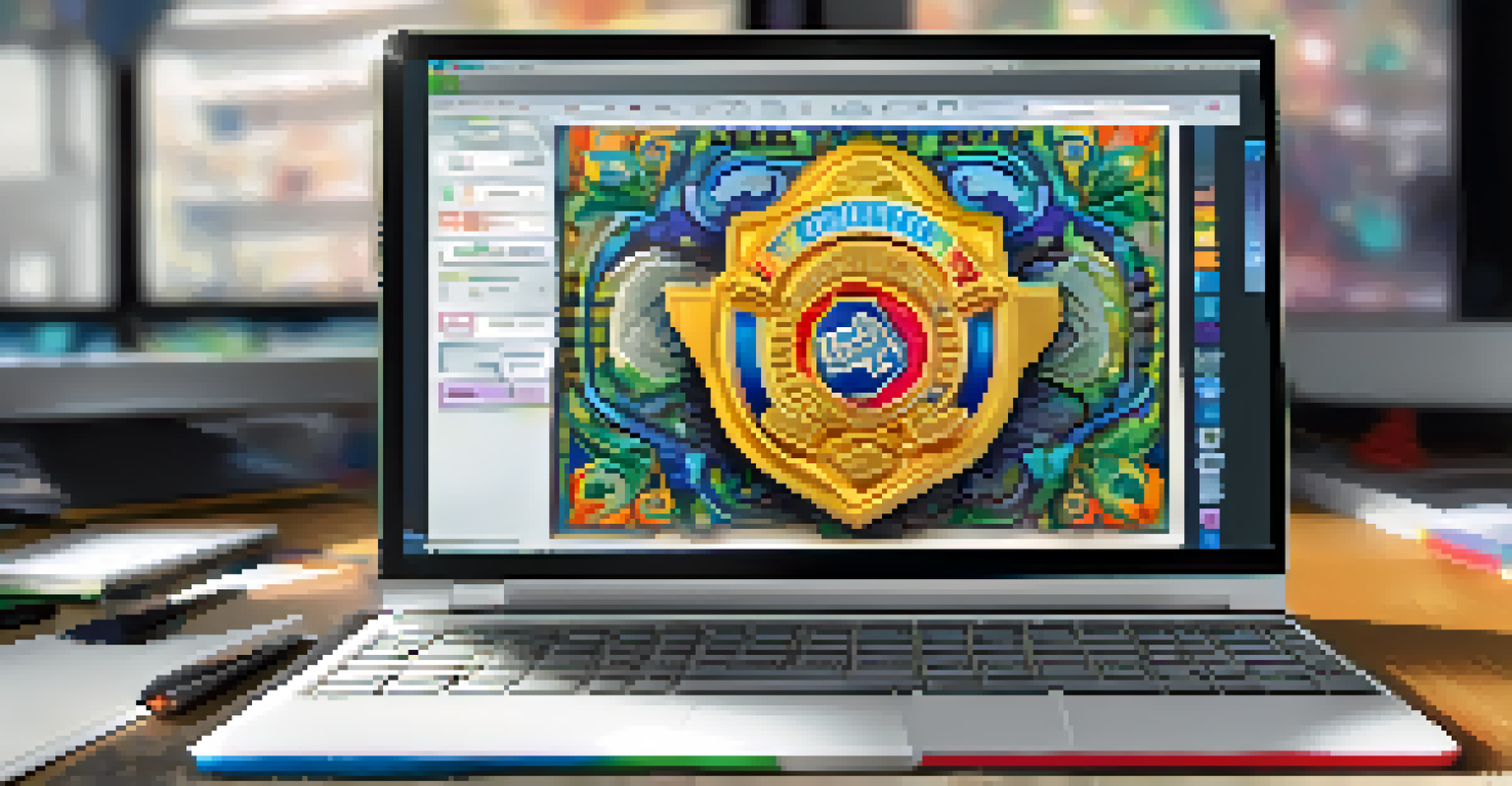Exploring the Use of Digital Badges in Higher Education Gamification

Understanding Digital Badges and Their Purpose
Digital badges are visual representations of achievements or skills earned by learners. They serve as a way to recognize accomplishments in a more engaging manner than traditional grading. By incorporating these badges, educational institutions can motivate students to pursue learning goals actively.
Badges are a way to recognize and reward learning in a way that is meaningful and visible to students.
At their core, digital badges are designed to provide a tangible recognition of a student's effort, much like earning a trophy in sports. They can be shared on social media or professional profiles, giving students a portfolio of their skills and accomplishments. This visibility not only boosts confidence but also enhances employability.
Moreover, the use of digital badges can help bridge the gap between formal education and real-world skills. As students collect badges, they can showcase a broader skill set that may not be evident through grades alone. This approach encourages lifelong learning and skills development, essential in today's fast-paced job market.
The Role of Gamification in Higher Education
Gamification involves integrating game-like elements into non-game contexts, such as education. This technique can transform the learning experience by making it more interactive and enjoyable. Students often respond positively to challenges and rewards, which can lead to higher engagement and retention rates.

By introducing elements like points, levels, and challenges, educators can create a more dynamic classroom environment. For instance, when students earn points for completing assignments or participating in discussions, they feel a sense of accomplishment. This competitive yet friendly atmosphere can motivate students to excel further.
Digital Badges Boost Engagement
Digital badges create a more engaging recognition system for learners, motivating them to pursue their educational goals.
Ultimately, gamification taps into intrinsic motivations, encouraging students to take ownership of their learning. When students are engaged and invested, they are more likely to explore topics deeply, leading to richer educational experiences. Digital badges fit seamlessly into this model, providing recognition for their efforts.
How Digital Badges Enhance Learning Experiences
Digital badges provide immediate feedback to students, allowing them to understand their progress in real-time. This instant gratification can be crucial in maintaining motivation throughout a course. The visual aspect of badges also serves as a constant reminder of what students have achieved and what they can still work towards.
Gamification in education leverages the natural human inclination to engage in games, creating a more exciting and effective learning environment.
Incorporating badges into coursework can also foster a sense of community among students. As learners share their achievements, they encourage peers to strive for their own badges. This collaborative spirit can create a supportive atmosphere where students feel empowered to take risks and explore new ideas.
Furthermore, badges can be aligned with specific learning outcomes, ensuring that students are mastering the required skills. For instance, a badge for completing a project could signify proficiency in critical thinking and problem-solving. This alignment helps students connect their achievements to real-world applications, enhancing the value of their education.
Implementation Strategies for Digital Badges
Implementing a digital badge system in higher education requires thoughtful planning and collaboration among faculty. Educators should start by defining clear criteria for earning badges, ensuring that students understand what is expected of them. This clarity makes the process transparent and encourages students to pursue their goals actively.
Additionally, institutions can leverage technology platforms to manage badge distribution and tracking. Many Learning Management Systems (LMS) now offer built-in features for creating and issuing badges. By utilizing these tools, educators can streamline the process, making it easier for students to engage with the system.
Gamification Enhances Learning
Incorporating gamification elements in education fosters student ownership of learning, leading to deeper exploration of subjects.
Finally, it's essential to promote the value of digital badges to both students and employers. Institutions can organize workshops or informational sessions to highlight how these badges can enhance resumes and LinkedIn profiles. By fostering this understanding, students can better appreciate the relevance of their achievements.
Challenges of Implementing Digital Badges
While the benefits of digital badges are clear, there are challenges to consider in their implementation. One significant hurdle is ensuring standardization across different programs and departments. Without a consistent framework, badges may vary in value and meaning, leading to confusion among students and employers.
Another challenge is the potential for students to focus more on earning badges than on the learning itself. If not carefully managed, the gamification aspect could overshadow the educational goals. Educators need to strike a balance, emphasizing that badges are a means to an end, not the end itself.
Lastly, technology access can be a barrier for some students. Institutions must ensure that all learners can participate in the digital badge system, regardless of their technological proficiency. Providing training and support can help level the playing field, making digital badges accessible to everyone.
Real-World Examples of Digital Badges in Action
Several institutions have successfully integrated digital badges into their curricula, showcasing their effectiveness. For example, Purdue University introduced a badge system for online courses, enabling students to earn badges for various skills and competencies. This initiative not only motivated learners but also provided employers with a clear understanding of candidates' abilities.
Another notable example is the University of California, Irvine, which implemented badges in its extension programs. Students can earn badges for completing specific courses or mastering particular skills, enhancing their professional profiles. This approach has proven beneficial in helping students stand out in competitive job markets.
Challenges in Badge Implementation
Standardization and access issues present challenges for effective digital badge systems in higher education.
These case studies illustrate that when implemented thoughtfully, digital badges can significantly enhance the learning experience. They provide recognition, motivation, and a tangible way for students to showcase their skills, all of which are invaluable in today’s education landscape.
The Future of Digital Badges in Education
The future of digital badges in higher education looks promising, with growing interest from institutions worldwide. As the job market increasingly values skills over traditional degrees, badges offer a flexible way for students to demonstrate their competencies. This shift could lead to a more personalized education experience tailored to individual strengths and interests.
Moreover, advancements in technology will likely enhance the functionality of digital badges. Features such as blockchain technology could provide secure storage and verification of badges, ensuring their authenticity. This innovation would further increase their value, making them a trusted indicator of a student's abilities.

As educators continue to explore the potential of digital badges, they must remain open to feedback and adaptation. Engaging students in the process can provide valuable insights into what works and what doesn’t. By fostering a culture of innovation, higher education can harness the full power of digital badges to enrich learning experiences.